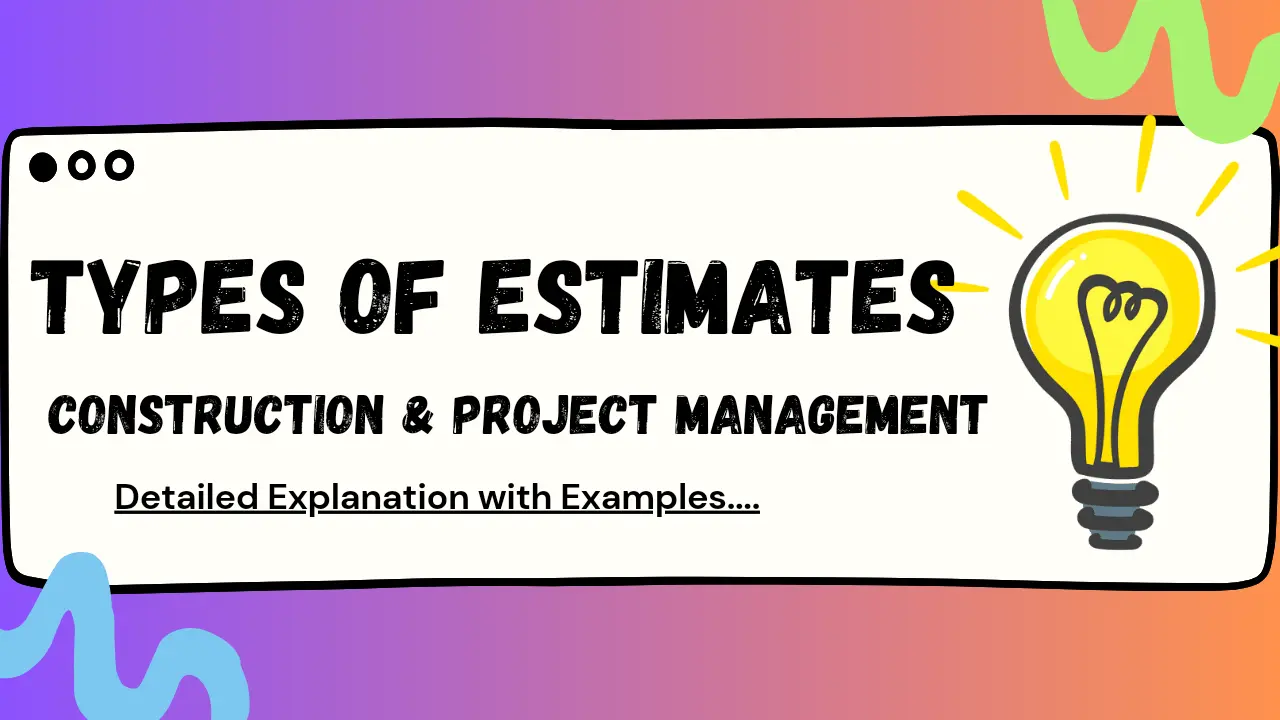Table of Contents
Estimate meaning in hindi – अनुमान लगाना
Types of Estimates in Construction
Estimates help us know how much money and time we need to build something. Let’s learn about different types of estimates!
Preliminary Estimate
A preliminary estimate is like a guess. We use it to see if a project is possible.
Characteristics:
- Based on basic project details
- Used for initial budgeting and feasibility
- Not very accurate (within 25-50%)
Example: Imagine you want to build a treehouse. You make a quick guess on how much wood, nails, and paint you need, without any detailed measurements. This helps you decide if you can afford it.
Detailed Estimate
A detailed estimate tells us exactly how much everything will cost. We use it to make sure we have enough money for the project.
Characteristics:
- Based on detailed plans and drawings
- Very accurate (within 5-10%)
- Used for final budgeting and contracts
Example: Before building the treehouse, you measure each part, make a list of materials, and calculate the exact cost. This ensures you have enough money and resources to complete the project.
Quantity Estimate
A quantity estimate counts all the materials we need. This helps us buy the right amount of stuff.
Characteristics:
- Focuses on materials needed
- Helps with buying supplies
- Accuracy depends on detailed plans
Example: You count how many pieces of wood, nails, and cans of paint you need for the treehouse. This ensures you buy the right amount and don’t run out of supplies.
Bid Estimate
A bid estimate is made by contractors when they want to win a job. It includes all costs plus their profit.
Characteristics:
- Prepared by contractors
- Includes profit margins
- Used for bidding on projects
Example: A builder gives you a price to build your treehouse. They include the cost of materials, labor, and a little extra for their profit. This is the bid estimate.
Revised Estimate
A revised estimate is made when something changes in the project. It updates the original estimate.
Characteristics:
- Adjusts for changes in the project
- Used for cost control
- Keeps the budget up to date
Example: If you decide to add a slide to your treehouse, the builder updates the estimate to include the new costs. This is the revised estimate.
Supplementary Estimate
A supplementary estimate is made when extra work is needed. It covers new costs that weren’t in the original plan.
Characteristics:
- Covers additional work
- Prepared during the project
- Ensures all costs are covered
Example: Halfway through building the treehouse, you decide to add a roof. The builder creates a supplementary estimate to cover the cost of the roof.
Plinth Area Estimate
A plinth area estimate calculates cost based on the building’s floor area. It’s quick and easy.
Characteristics:
- Based on floor area
- Quick to prepare
- Used for houses and buildings
Example: For a house, you measure the area of the ground floor and use a standard cost per square foot to estimate the total cost.
Cubic Content Estimate
A cubic content estimate calculates cost based on the building’s volume. It’s good for tall buildings.
Characteristics:
- Based on building volume
- Used for tall structures
- Provides a 3D cost view
Example: For a multi-story building, you calculate the cost based on the total volume of the structure (length x width x height).
| Type of Estimate | Purpose | Accuracy | Example |
|---|---|---|---|
| Preliminary Estimate | Initial budgeting and feasibility | Low (25-50%) | Guessing the cost of a treehouse |
| Detailed Estimate | Final budgeting and contracts | High (5-10%) | Exact cost for a treehouse with measurements |
| Quantity Estimate | Material procurement | Medium | Counting wood, nails, and paint for a treehouse |
| Bid Estimate | Bidding for projects | Varies | Builder’s price for building a treehouse |
| Revised Estimate | Adjusting for changes | High | Adding a slide to a treehouse |
| Supplementary Estimate | Covering additional work | High | Adding a roof to a treehouse |
| Plinth Area Estimate | Quick cost calculation | Medium | Cost per square foot for a house |
| Cubic Content Estimate | Cost based on volume | Medium | Cost for a multi-story building |
Types of Estimates in Project Management
Estimating is a critical process in project management. It helps determine the amount of resources, time, and budget required to complete a project. Here are the main types of estimating techniques used in project management:
1. Analogous Estimates
Analogous estimating, also known as top-down estimating, involves using the actual cost of previous, similar projects as the basis for estimating the cost of the current project.
Characteristics:
- Based on historical data
- Quick and easy to use
- Less accurate
Example: If a previous project of building a small office cost $100,000, and the current project is similar, the estimate might be around $100,000.
2. Parametric Estimates
Parametric estimating uses statistical relationships between historical data and other variables to estimate project costs. This method involves creating a mathematical model based on project parameters.
Characteristics:
- Based on statistical data
- More accurate than analogous estimating
- Requires detailed historical data
Example: If building a house costs $150 per square foot, and the new house is 2,000 square feet, the estimate would be $300,000.
3. Bottom-Up Estimates
Bottom-up estimating involves estimating the cost of individual tasks or components and then summing them to get the total project cost. This method is detailed and time-consuming but highly accurate.
Characteristics:
- Highly detailed
- Very accurate
- Time-consuming
Example: Estimate the cost of each task in building a house (e.g., foundation, framing, roofing) and sum them to get the total project cost.
4. Three-Point Estimates
Three-point estimating involves calculating three different estimates: optimistic (O), pessimistic (P), and most likely (M). The final estimate is calculated using the formula: (O + 4M + P) / 6.
Characteristics:
- Accounts for uncertainty
- Provides a more balanced estimate
- Uses three different scenarios
Example: If the optimistic estimate is $90,000, the pessimistic estimate is $110,000, and the most likely estimate is $100,000, the final estimate would be ($90,000 + 4*$100,000 + $110,000) / 6 = $100,000.
5. Expert Judgment
Expert judgment involves consulting with experts who have experience and knowledge about similar projects. Their insights and opinions help in forming the estimate.
Characteristics:
- Based on expert insights
- Can be quick and efficient
- Subjective and may vary
Example: Consulting with an experienced project manager who has overseen similar projects to estimate the cost of a new project.
6. Reserve Analysis
Reserve analysis involves adding extra funds to the project budget as a contingency reserve to cover unforeseen expenses. This method ensures that the project is not stalled due to unexpected costs.
Characteristics:
- Adds a buffer to the budget
- Helps manage risks
- Ensures project continuity
Example: If the estimated project cost is $100,000, adding a 10% reserve would increase the budget to $110,000 to cover any unexpected costs.
| Type of Estimating | Purpose | Accuracy | Example |
|---|---|---|---|
| Analogous Estimating | Uses historical data for similar projects | Low | Estimating the cost of a new office based on a previous one |
| Parametric Estimating | Uses statistical relationships | Medium | Estimating house cost by price per square foot |
| Bottom-Up Estimating | Detailed task-level estimates | High | Summing costs of all tasks to build a house |
| Three-Point Estimating | Uses optimistic, pessimistic, and most likely estimates | Medium | Calculating an estimate using three scenarios |
| Expert Judgment | Relies on expert insights | Varies | Consulting an experienced project manager |
| Reserve Analysis | Adds contingency funds | Medium | Adding 10% reserve to the budget |
Download Free Building Estimation Excel Sheet
Download Free Road Estimation Excel Sheet
FAQ – Estimates in Construction & Project Management
What is a Preliminary Estimate?
A preliminary estimate is an early-stage guess of how much a construction project will cost. It is based on basic project details and is used to determine if the project is feasible. This estimate is not very accurate and is usually within 25-50% of the final cost.
How is a Detailed Estimate different from a Preliminary Estimate?
A detailed estimate is much more accurate than a preliminary estimate. It is based on detailed plans and drawings and includes a comprehensive breakdown of all costs, such as materials, labor, and equipment. This estimate is used for final budgeting and contracts and is typically within 5-10% of the actual cost.
Why is a Quantity Estimate important?
A quantity estimate is important because it calculates the exact amounts of materials needed for a construction project. This helps in purchasing the right quantities, preventing shortages or excess, and ensuring efficient resource management
When is a Revised Estimate necessary?
A revised estimate is necessary when there are significant changes in the project scope, design modifications, or unforeseen conditions that affect the original estimate. It updates the original estimate to reflect the new requirements and costs, ensuring that the budget remains accurate and up-to-date.
How accurate is a detailed estimate?
A detailed estimate is quite accurate because it is based on comprehensive project plans and drawings. It typically has an accuracy level of within 5-10% of the actual costs. This type of estimate is used for final budgeting and contract agreements.
Why do contractors use bid estimates?
Contractors use bid estimates to determine how much they will charge to complete a project. This estimate includes all costs like labor, materials, and overheads, plus a profit margin. It is used to make competitive bids for construction projects.
What is the purpose of a revised estimate?
A revised estimate is prepared when there are changes or additions to the project after the initial estimate. It updates the original estimate to reflect new costs and ensures that the budget remains accurate and manageable.
What is a supplementary estimate?
A supplementary estimate is created when additional work is required that was not included in the original project scope. It accounts for extra costs that arise during the project, ensuring that all new expenses are covered.
YouTube Video About Estimation

Hi! I’m Sandip, a civil engineer who loves sharing about Civil Engineering & new ideas and tips. My blog helps you learn about engineering in a fun and easy way!

